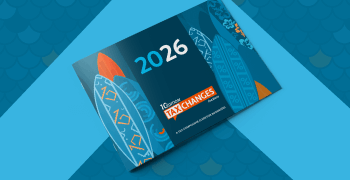Hawaii may increase the sales tax rate … in 2050 – Wacky Tax Wednesday
Having a long-term financial plan and budget is widely regarded as a good thing for both businesses and individuals. Yet although all states (except Vermont) are required to balance their annual or biennial budgets, many “fail to produce multi-year spending plans.” So, how far ahead do states plan?
At least one state has a long-term plan with respect to sales tax — or in its case, the General Excise Tax (GET). A measure making its way through the Hawaii Legislature would increase Hawaii’s GET rate for persons engaged in the business of selling tangible personal property by 0.5 percent, but not until 2050. Now that’s what I call planning ahead.
The first iteration of Senate Bill 1474 didn’t have an effective date of 2050; in fact, it didn’t have an effective date at all. The Hawaii Department of Education then requested an effective date “no earlier [than] January 1, 2020 to give the Department sufficient time to implement the changes required by this measure.”
The Senate Committees on Education and Higher Education ran with that suggestion, setting the effective date at July 1, 2050, in the second iteration of the measure, “to encourage further discussion.” The 2050 start date was kept in the third and final iteration, which was approved by the Senate 21–3 on March 5, 2019.
The 2050 GET hike is now awaiting consideration in the House. If approved, it will raise revenue for the Department of Education and the University of Hawaii. Another bill proposing the same GET increase with an earlier effective date is stuck in the Senate Ways and Means Committee. SB 1373 sets an effective date of January 1, 2031.
Proposal to enforce income tax economic nexus
Still another measure making its way through the Hawaii Legislature is also looking ahead to 2050.
Under Senate Bill 495 SD2 (the third iteration of that bill), a person without physical presence in Hawaii is presumed to be engaged in business in the state if the person has $100,000 or more in gross income from sources in Hawaii or engages in 200 or more transactions with persons in Hawaii in the current or previous calendar year. The bill is effective upon approval and applies to taxable years beginning after December 31, 2018. However, the measure has an effective date of 2050. What’s up with that?
The $100,000 sales/200 transactions threshold is the same as Hawaii’s sales tax economic nexus threshold. As of July 1, 2018, remote retailers with more than $100,000 in gross income from the sale of tangible personal property, intangible property, or services delivered in Hawaii, or at least 200 transactions of the same in the state, are subject to the GET.
It’s unusual for states to plan tax hikes and new tax requirements for more than 30 years in the future. According to Scott Peterson, Vice President of U.S. Tax Policy and Government Relations at Avalara, “A good state budget officer will look out 10 years for capital improvements,” and a new governor should look out eight years. “No state has any idea what their budget will look like 20 or 30 years hence.”
Maybe the Legislature’s focus on 2050 is a stellar example of long-term financial planning, like a 22-year old with a 401(k). Or maybe it’s just “island time.” Whatever the reason, it’ll be interesting to see what comes of the proposed GET hike and income tax economic nexus plan. We’ll let you know more in the Avalara blog as soon as we know more.

Avalara Tax Changes 2026 is here
The 10th edition of our annual report engagingly breaks down key policies related to sales tax, tariffs, and VAT.
Stay up to date
Sign up for our free newsletter and stay up to date with the latest tax news.














